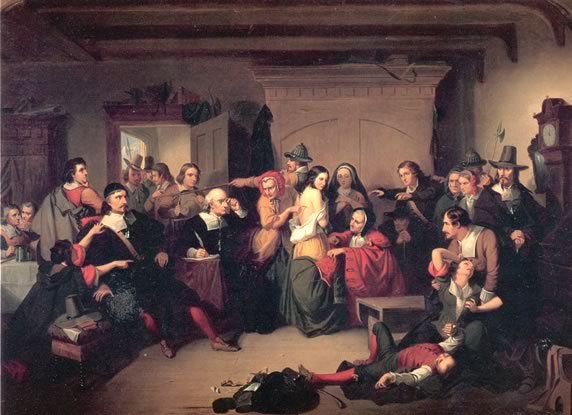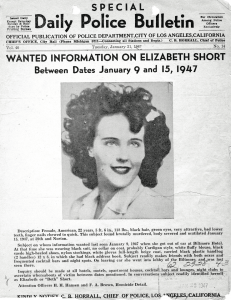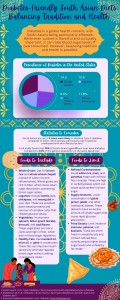Why would adults in Salem, Massachusetts in the 1690s take the accusations of nine year old girls seriously? During the seventeenth century, New England had grown diverse. The people living in the communities were of different backgrounds. But in the 1690’s there was an apparent outbreak of witchcraft. The most famous of these outbreaks was the event in Salem, Massachusetts in 1692 that stirred up the Salem community and soon spread to other communities.
The widespread hysteria over witches was all over the town after an accusation of witchcraft was made in January 1692. A group of young adolescent girls met in the home of Samuel Parris, a Puritan pastor in Salem. The pastor had a nine year old daughter, Betty. Betty and her cousin Abigail were fascinated by the voodoo tales and tricks told to them by the family slave. The family slave, Tituba, was the one whom the little girls had sought after for entertainment.1 It was not long after their time spent with Tituba, when the girls began to behave strangely; seeing visions, babbling at times, and lapsing into trances. The Puritans thought that these behaviors were of witchcraft, as the work of the devil. People in Salem began believing the girls, and charged Tituba and two other village women for practicing witchcraft on them. Two men, John Hathorne and Johnathan Corwin of Massachusetts, were called to do a legal examination of the women. The Puritans followed the Old Testament law. This was how they assessed the examinations. Scripture had a statement that said witches were not able to live. The two men knew exactly what they had to do. The examination was done on these women of Salem by looking for a certain mark on the body: a wart or tit. This specific mark was said to be the place where the devil and his demons would take blood out of the witch.2 Many of the women accused were of lower status in the community.

Research shows most of the accused witches were middle-aged women, widowed, with few or no children. Also, if the woman had been involved with domestic conflicts, they were accused. The women were accused of crimes and appeared to be dangerous by their neighbors. Women in Salem who inherited or possessed land were also accused of witchcraft.3 The accusations towards these women were out of the ordinary and seemingly wrong. One must first think about the view of women during this time. They were undermined and portrayed as having no power or knowledge of such things; they were subservient to the men in the community. Not only were low class women accused of witchcraft, but as time passed, superior women were accused as well.4
On October 29th, the Salem Witch Trials were called to an end. Governor Phips dismissed the Court and that marked the end to the witch hunt craze. Many were disappointed about the ending of the trials, but many were glad to return to work.5 The community in Salem blamed Pastor Parris for letting the innocent die. The people of the Salem church also voted to void his salary. In the following years, those family members of the deceased were restored their good names. The families were awarded a compensation for all the financial loses they went through during such tragic times. Increase Mather, a pastor of the Boston Puritan Church, wanted the people to do away with the court because he believed they put innocent people to death.
The Witch trials took on an important role in American History. The trials became a tragic and memorable moment in history. Generational, racial, and sexual hostility, opposition to law, social stresses, and food poisoning were all causes as to why the people had anxieties that found release in the witch hunt craze. The witch hunts became searches for scapegoats; the community leaders were looking for anyway possible to ease the community’s anxieties.6
- Kenneth P. Minkema, “In the Devil’s Snare: The Salem Witchcraft Crisis of 1692,” The Christian Century, no. 8 (2003): 37. ↵
- Salem Press Encyclopedia, January 2015, s.v. “Salem Witchcraft Trials,” by Warren M. Billings and Kimberly Manning. ↵
- Alan Brinkley, American History, 15th ed., vol. 1: to 1865 (2 Penn Plaza, New York, NY 10121: McGraw Hill Education, 2015), 86-87. ↵
- Salem Press Encyclopedia, January 2015 s.v. “Salem Witchcraft Trials,” by Warren M. Billings, Kimberly Manning. ↵
- Salem Press Encyclopedia, January 2015 s.v. “Salem Witchcraft Trials,” by Warren M. Billings, Kimberly Manning. ↵
- Salem Press Encyclopedia, January 2015 s.v. “Salem Witchcraft Trials,” by Warren M. Billings and Kimberly Manning. ↵



178 comments
Natalia Flores
The Salem Witch Trials really makes me question weather humans are truly human or scared animals who happen to walk on two legs. Its barbaric and idiotic that people could carelessly kill women on the smallest of things and that nobody stood up to that. I like how the article pointed out why women were singled out and which women were more likely to become a target.
Hector Garcia
The Salem Witch Trials would be one of the most horrible periods in U.S. History because of how people were treated. It is dehumanizing to read of who women were unjustly tried for accusations of witchcraft. I’m just glad that terrible time period end, but not without the massive loss of lives. Overall, I feel like the author was able to describe with accuracy, the events in the Salem Witch Trials.
Anna Guaderrama
Yikes, this article just seems disturbing to me. Short, yet perfectly detailed I feel like it perfectly captured the story of and overall idea. It’s crazy to think that at some point in history this was actually a thing that people feared…I mean, the idea of witchcraft seems stupid…or at least for people who don’t believe in it. Maybe in some cultures it’s more a prominent idea, but this by far has always stuck out as something iconic for American history.
Hannah Wilson
This is a disturbing article. It is short, yet detailed and kept me captivated. I find it strange that the little girls were acting so strangely, and it makes me curious to what the real cause might have been .The witch trials had to be a challenging time for women in Salem. They were already supposed to remain silent and have no power. So, they would have been under trial and have no actual power or say in the situation.
Destiny Flores
The iconic which hunt is obviously well known. It’s also well known that humans fear things they don’t understand, and often in fear, people act out in hostility. It’s mind boggling to think how far these people went just because they didn’t quite understand people that weren’t like them. And it makes it even harder to believe that young girls, children, fell victim to this widespread fear.
Saira Castellanos
I mean who hasnt heard of the Salem Witch Trials. I had read the play The Crucible, and I loved the story. I know that Tituba was the first person killed because of a witch accusation. Although The Crucible was not completely true, it did have some parts in it that really did happen, like all those girls acting strange and then the trials beginning. Honestly, the trials is a huge black mark on American history. And i am sure that if there were such thing as witches, they would be too smart to get caught, so they were just killing a ton of innocent women.
Belia Camarena
Great job on this article! It was interesting, and very in depth. I was amazed to read all of the reasons that women were accused of witchcraft. The one that really stood out to me was that women could be accused if they inherited or possessed land. The inequality that women faced is astounding, and it shows that women have made societal progress.
Kimberly Simmons
It’s quite interesting that these girls started acting so strangely. I have heard many stories of the Salem Witch Trials, but never one so in-depth. Women in this time period were already seen as being of lesser value, so it was probably easy to place the blame of witchcraft on them. This article accurately pinpoints the inequality against women both legally and socially, while also giving a brief yet filling description of the story of the trials. Well done!
Alexandra Cantu
I was curious to read about the Salem Witch Trails as I have always wanted to know more. I find it speechless how they believed a couple of young foolish girls because they started to act differently. I mean a witch c’mon! Its not possible. But anyways I can’t believe the community continued this nonsense by murdering many women of all status just if they had a mole. Now thats crazy! Thankfully this all came to end and they compensated all the families that were suffered.
Alyssa Childs
I was very intrigued to read yet another story on the Salem Witch Trials, which is solely why I chose to read this article. I had a sense of what the article would talk about and I believe the author, Oscar Sepulveda, did a swell job summarizing the gist of the infamous story. I am astonished with how much the adults believed these children because nowadays adults typically don’t believe the millennials in almost anything they say, especially if it has something to do with witchcraft, ghost, and monsters.